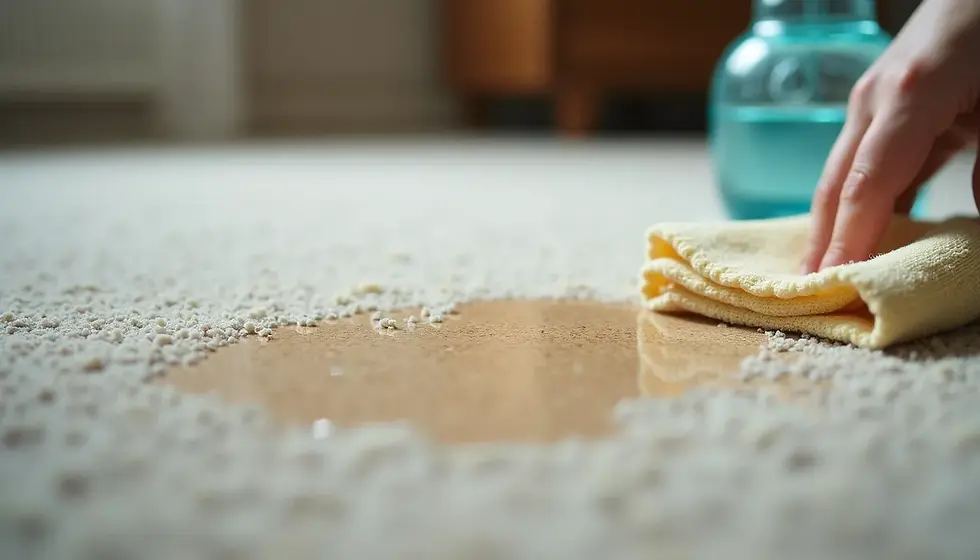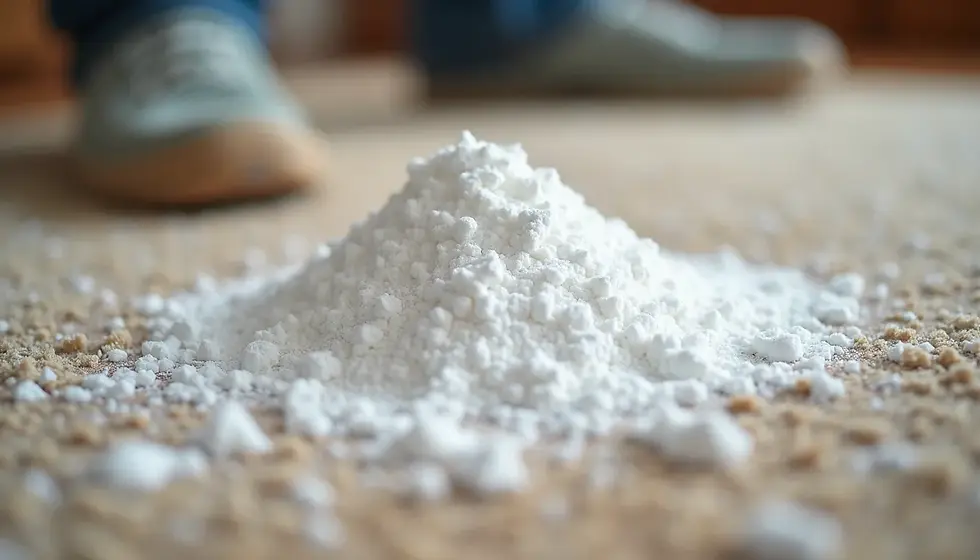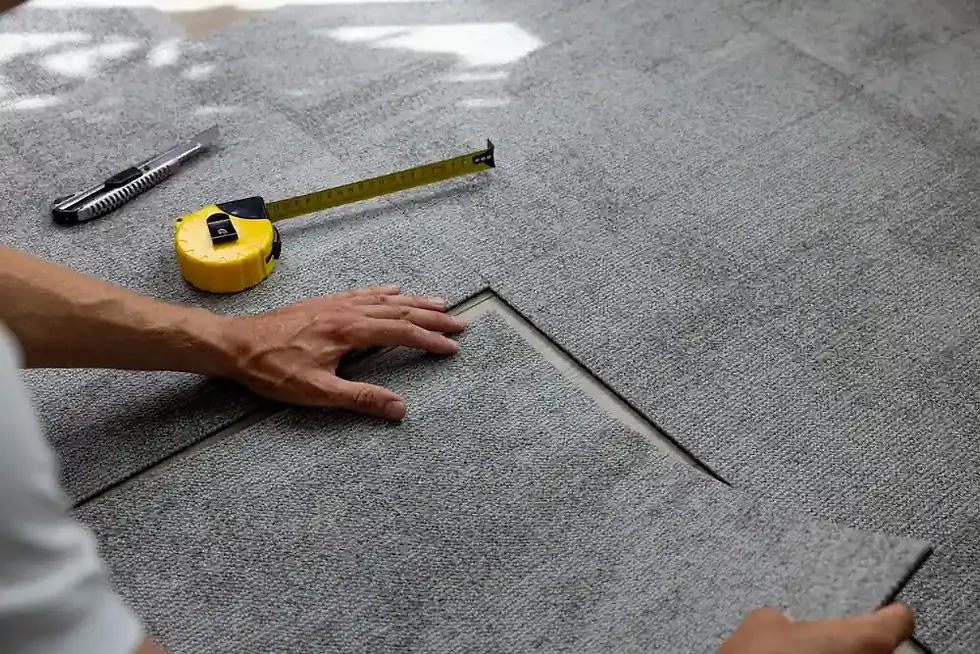How to Get Slime Out of Carpet: No-Panic Guide Homeowners 🧽
- Mei-Lin Arora

- Sep 1
- 9 min read
Updated: Sep 7
Slime is awesome… until it glues itself to your living-room carpet. The bright color, stretchy texture, and sticky polymers make cleanup feel impossible—especially when it dries in. The good news: with the right method (and a little patience) you can remove it completely without destroying the pile, fading the dye, or violating your carpet warranty.
This guide shows you exactly how to get slime out of carpet—from fresh spills to hardened globs in high-pile rugs—plus pro-grade ways to prevent stains, rescue color, and deodorize safely.
If you’ve ever found fresh slime smeared across the living room or discovered a dried patch days later, you’ve probably wondered the same thing: how do you actually get slime out of carpet without ruining it? Whether the mess is fresh, dry, or stubbornly stuck, there are safe methods that work on all of them. I’ll walk you through step-by-step playbooks, explain why each step works, and flag the common mistakes that set stains permanently. Let’s save your Saturday—and your carpet.

Why Slime Sticks (and What That Means for Cleaning)
Most DIY and store-bought slimes combine polyvinyl alcohol (PVA) glue with a borate activator, plus dyes, glitter, or shaving-cream foam. When that hits carpet:
The polymer network grabs fibers and dries as a film along each strand.
Dyes and glitter wedge into the pile.
Fragrances, lotions, or shaving cream add oils that attract soil.
Translation: you need to (1) mechanically lift the bulk, (2) soften or dissolve the polymer without bleaching the carpet, (3) float out the residue and dye, and (4) rinse/extract so nothing sticky remains to re-soil later. Industry groups emphasize the same fundamentals for spots and stains: act promptly, blot (don’t scrub), test cleaners, and extract thoroughly.
For a trustworthy refresher on carpet-spot basics, see the Carpet & Rug Institute’s guidance and Spot Solver tool (great for many stains, and helpful principles for slime, too): CRI cleaning & maintenance overview and the CRI Spot Solver. More info here: CRI spot tips.
Tools & Safe Supplies (What to Grab Before You Start)
Dull spoon or plastic scraper
Ice cubes (to harden fresh slime fast) and a zipper bag
Small soft brush (old toothbrush or upholstery brush)
White vinegar (5% household), mild dish soap, and warm water
Isopropyl alcohol (70–91%) for dye residue and sticky films
Hydrogen peroxide 3% (light carpets only; spot-test)
Oxygen bleach (color-safe, non-chlorine; optional for stubborn color on light carpet)
White towels or paper towels
Spray bottles (labeled), measuring spoons
Wet/dry vac or carpet spot extractor (ideal but optional)
Fans for fast dry-down
Safety & warranty notes
Always spot-test in an inconspicuous area.
Avoid chlorine bleach—it can strip color and damage fibers.
Use cool to lukewarm water; high heat can set dyes (a general stain-removal rule echoed by long-standing consumer resources). For a simple, dependable spot-treating primer (blot, don’t rub; mix mild solutions), see Consumer Reports’ carpet stain guide. More info here: Consumer Reports—Carpet Stain Removal Guide.

How to Get Slime Out of Carpet (Fresh Spill Playbook)
Goal: remove the bulk, prevent dye transfer, and avoid pushing slime deeper.
Harden fast. Place ice cubes in a bag and press onto the slime for 5–10 minutes. The slime stiffens, so it releases in larger chunks instead of smearing.
Lift, don’t smear. Use a spoon to chip upward at the edges and lift off the mass. Move to a clean paper towel frequently so you don’t redeposit.
Pre-treat the film (vinegar or soap). Mix 1 part white vinegar to 2 parts water in a sprayer and lightly mist the residue. Wait 3–5 minutes. Alternatively, dab a drop or two of mild dish soap onto the film, then mist with water.
Agitate gently. Work in small circles with a soft brush. The residue should start loosening; blot with a white towel between passes.
Rinse & extract. Mist with plain water and blot (or extract with a wet vac). Repeat light vinegar/soap cycles until the towel lifts clean.
Neutralize the vinegar smell. Final rinse with water and blot dry. Place a dry towel over the spot and weigh it with a book for 30 minutes. Finish with a fan.
Why this works
Cooling stiffens the polymer network so it fractures off the fiber instead of smearing.
Mild acids (vinegar) help loosen PVA films; surfactants (soap) break surface tension and lift soils. General carpet-spot rules emphasize blotting and gentle action to protect pile—again, see CRI spot-cleaning principles and Consumer Reports’ “blot, don’t rub” reminder. More info here: CRI stain tips and Consumer Reports—Carpet Stains.
How to Get Dried Slime Out of Carpet (Deep-Clean Sequence)
If the slime is crusted in—maybe you found it the next day—use this slower, safer approach.
Dry chip first. With a spoon, chip off as much dry slime as possible. Vacuum up fragments.
Soften the residue. Lightly mist a 1:2 vinegar:water solution; wait 10 minutes. For thick build-up, cover with plastic wrap during dwell time to prevent evaporation.
Break the bond. Brush gently to raise softened film. Blot with a towel. Repeat mist → dwell → brush → blot until the towel shows minimal transfer.
Target dyes or sticky shine (optional). If a faint colored cast remains or the spot feels tacky, dab isopropyl alcohol onto a towel and blot (don’t pour). Work from the outside in. Blot damp with plain water after.
Color rescue for light carpets (optional). For lingering dye on light, color-fast carpet, apply 3% hydrogen peroxide on a cotton swab. Tap lightly, wait 5 minutes, then blot and rinse. Do not use on wool or silk; always spot-test.
Rinse & extract thoroughly. Mist with water and wet-vac or blot until towels stay mostly white.
Dry fast. Lay a clean dry towel, weigh it down 30–60 minutes, then run a fan. Quick dry prevents wick-back (stain returning as deeper moisture rises).
If you like having a “second opinion” while you work, the American Cleaning Institute maintains reliable stain-removal basics and spot-treating principles (blot, small amounts of solution, test first). Click here for a simple refresher: American Cleaning Institute—Stain Removal Guide. cleaninginstitute.org
How to Get Slime Out of Carpet (H2 With Main Keyword): The Pro Pattern You’ll Repeat
Here’s the core pattern pros follow—use it for both fresh and dried slime.
Remove bulk (chip or freeze-and-lift).
Soften residue (vinegar solution or a few drops of mild detergent).
Agitate lightly (soft brush); blot with white towels.
Rinse/extract (water mist + blot or wet vac).
Spot-treat color (alcohol or 3% hydrogen peroxide on light, colorfast carpets only).
Dry fast (towel + fan) to prevent wick-back and odors.
This mirrors best-practice stain removal fundamentals—blotting vs. rubbing, minimal wetting, and prompt extraction—reinforced by carpet industry resources. If you want a quick visual on spot principles and downloadables, bookmark CRI’s cleaning pages and standards. More info here: CRI Cleaning & Maintenance and CRI Cleaning Standards page.
Special Cases (So You Don’t Accidentally Set the Stain)
Glitter slime
Vacuum extra glitter first with a crevice tool. Then follow the standard sequence. If a few flakes remain, lift with a lint roller rather than scrubbing.
Foamy/shaving-cream slime
Expect leftover surfactant (soapy residue) that can attract dirt. Rinse extra well with water and extract thoroughly.
Scented or lotion-based slime
You may feel a waxy film after vinegar steps. Dab isopropyl alcohol on a towel and blot—alcohol is better than vinegar for oily residues. Follow with a water rinse and blot.
Wool carpet or natural fibers (sisal, seagrass)
Be extra gentle; avoid high alkalinity and over-wetting. Stick to mild soap, water, blotting, and fast drying. Consider calling a wool-safe pro if the patch is large.
Delicate rugs (viscose/rayon, silk blends)
Skip DIY chemicals; these fibers brown and mat easily. Lift bulk, then consult a rug specialist.

What Not to Do (The Mistakes That Make Slime Permanent)
Don’t scrub hard. Friction felts fibers and pushes dye deeper.
Don’t soak the pad. Over-wetting causes wick-back and odors.
Don’t use chlorine bleach. It can strip color and damage fibers.
Don’t use hot water first. Heat can set dyes and fix the film.
Don’t skip the rinse/extract. Any sticky residue will re-soil quickly.
Long-standing consumer and industry resources repeat these points for carpet care (blotting > rubbing; be sparing with solutions; test first). For an accessible, evergreen primer, see Consumer Reports’ carpet stain guide and CRI’s spot best practices. More info here: CR stain basics and CRI—Carpet Stains 4-1-1.
Troubleshooting: If Color Lingers or the Spot Returns
The stain “reappears” tomorrow (wick-back).
That’s moisture from the pad wicking dissolved color back up. Re-treat lightly: mist water, blot, then press a dry towel under weight for a full hour. Aim a fan at the spot.
You still see a tinted halo (especially neon slimes).
Try a dilute oxygen bleach solution (color-safe, non-chlorine) on light-colored, colorfast carpet only. Dab; wait 5 minutes; blot; rinse. Always spot-test first.
It feels sticky after drying.
That’s residue. Mist warm water, blot, repeat. A quick isopropyl alcohol blot can cut leftover stickiness; follow with a water blot.
The pile looks matted.
After drying, groom the pile with a spoon edge or soft brush while you blow a fan across the fibers. Severe matting may need a pro’s steam extraction and grooming.
You’re worried about damage or warranty.
Check your carpet brand’s care guide and look for CRI-approved products or a CRI-certified cleaning firm. The Carpet & Rug Institute maintains standards and directories. Click here to explore standards and spot guidance: CRI Spot Solver + Standards.
The Chemistry Angle You Can Actually Use (Why Vinegar & Alcohol Help)
Vinegar (weak acid) helps loosen PVA-based residue and keeps dyes from spreading by slightly acidifying the environment.
Surfactants in mild dish soap reduce surface tension so the solution can penetrate the film and float soil.
Isopropyl alcohol evaporates quickly and is great at lifting oily binders and some dyes—which is why it’s the right “second wave” if a tinted halo lingers.
You’ll see these fundamentals reflected across cleaning institutes and consumer testing sites: start mild, be sparing, blot, and escalate carefully. For a trusted, general-purpose spot-treating reference to keep on hand, the American Cleaning Institute has a long-running stain hub. More info here: ACI—Stain Removal Guide.
Prevent Slime Nightmares (Set-It-and-Forget-It Habits)
Slime zone rules. Keep slime play at a table with a vinyl mat or on hard floors.
Color choice. Light or glitter-free slimes stain less; neon and dark colors transfer more dye.
Containers. Store slime in sealed tubs; toss if it gets runny or separates.
Carpet care. Vacuum weekly and more in high-traffic areas; regular dry soil removal protects fibers and makes future spot cleanup faster. CRI’s downloadable care guide reiterates weekly vacuuming and more on high-traffic zones. More info here: CRI Carpet & Rug Care Guide (PDF).
Quick “What If…?” Answers (Because Real Life Is Messy)
Q: How to get slime out of the carpet fast before guests arrive?
A: Freeze-and-lift, vinegar mist 3 minutes, brush lightly, blot, water rinse, blot, fan. Five steps, <20 minutes for small spots.
Q: How to get slime out of a carpet that’s shag/high-pile?
A: Chip off bulk; comb the pile with a wide-tooth comb as you work vinegar/soap in small sections; extract with a wet vac to pull solution from deep loops.
Q: How to get dry slime out of a carpet with neon dye?
A: After vinegar cycles, use isopropyl alcohol on a towel (blot only). On light carpet, tap 3% hydrogen peroxide with a swab for the last 5% of color, then rinse and dry.
Q: Can I use a carpet machine?
A: For small areas, manual blot/extract is safer. If you use a machine, choose cool water, minimal solution, lots of rinse/extract passes, and fast drying.
Q: When should I call a pro?
A: If the spot covers >1 sq ft, if it’s on wool/viscose, if the pad is saturated, or if there’s still a halo after two careful cycles. Look for a provider who follows CRI standards.
Reference-Backed Extras (If You Want More Reading)
Consumer Reports’ classic carpet-stain guide (blotting, mild solutions, quick action) is a great second opinion while you work: Carpet Stain Removal Guide. Consumer Reports
Carpet & Rug Institute—spot solver and care standards you can trust for carpets and rugs: CRI Spot Solver and CRI Cleaning & Maintenance. The Carpet and Rug Institute+1
American Cleaning Institute—long-standing basics for safe spot removal, testing, and product use: ACI Stain Guide. cleaninginstitute.org
(These sources have been online for years and are regularly maintained; they’re reliable “evergreen” references for carpet care and stain removal.)
One-Page Cheat Sheet (Screenshot This)
Freeze → lift chunks → vinegar/soap mist → brush lightly → blot → rinse/extract → fast dry.
For stubborn color: isopropyl alcohol (blot, then water blot). Light carpet only: 3% hydrogen peroxide touch-ups.
Never scrub hard, never soak, never chlorine bleach.
Vacuum weekly; restrict slime to hard-surface “play zones.”
Conclusion: How to Get Slime Out of Carpet—Confident, Repeatable, and Safe 🙂
You now have a repeatable, warranty-friendly plan for how to get slime out of carpet—and for how to get dried slime out of carpet when you discover it later. For fresh messes, freeze-and-lift followed by a vinegar (or soap) dwell and gentle blotting gets you 90% there. For stubborn color on the last 10%, alcohol (and on light carpets, 3% hydrogen peroxide) finishes the job. If you ever wonder how to get slime out of a carpet with glitter or foam, treat glitter with vacuum + lint roller first, rinse foam residue thoroughly, and dry fast to prevent wicking.
With these steps—and a couple of set-it-and-forget-it habits like weekly vacuuming and a “slime zone” on hard floors—you’ll handle future spills in minutes, not hours.



Comments